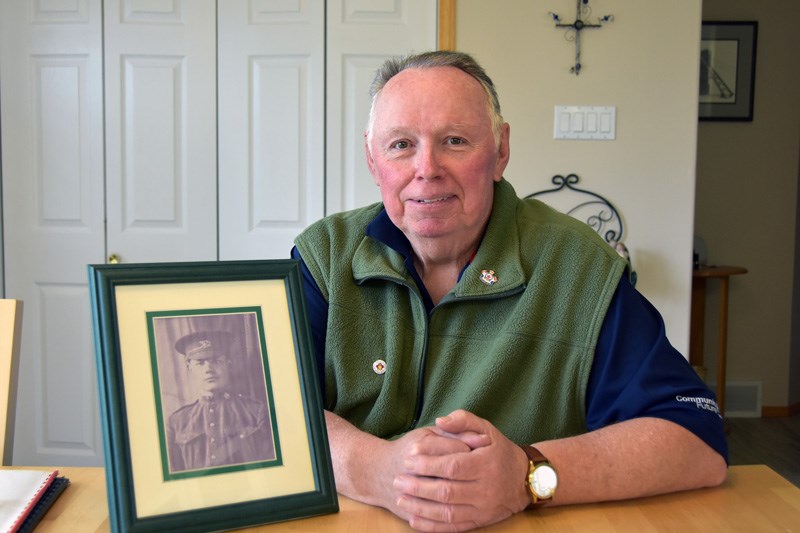Anyone who studies history will know that the First World War was one of the deadliest conflicts in collective memory. It was known as “The Great War” and “The War to End All Wars” and it took a horrible toll on combatants from both sides. The total number of military and civilian casualties in the war was more than 38 million (17 million deaths and 20 million wounded); 61,000 of those deaths were Canadians with another 172,000 wounded. Counted among the deaths were numerous soldiers from Manitoba.
The battles in World War I were so horrific that some soldiers were lost on battlefields and presumed dead. Families of the lost were left to wonder what happened to loved ones who went off to war and were never heard from again. Such was the case when, earlier this month, bones found six years ago outside a French village were identified as those of a Manitoba soldier with two Snow Lake connections. Private Reginald Joseph Winfield Johnston of Fairford, Manitoba was identified through a review of historical facts, forensic evidence and DNA testing. He was a great-uncle to locals Joanne Schuman and Rupert Klyne.
The private was a member of the 16th Battalion, Canadian Expeditionary Force and was believed to have been killed in the Battle of Hill 70 on Aug. 15 or Aug. 16, 1917. His remains were found in August 2011, during a munitions clearing process prior to construction near Vendin-le-Vieil, France.
The Battle of Hill 70 was the first major Canadian action fought for a strategic high point in the war. Approximately 2,100 Canadians perished in the battle. More than 1,300 have not been formally interred.
Joanne Schuman says that the process to identify her great-uncle’s remains came about over a 10-year period. It started when another great-niece from Manitoba travelled to Vimy in 2007 for the 90th anniversary of the battle and left her name and some info in the Book of Remembrance there. “When the remains were found and there was a possibility they belonged to our great-uncle, she was tracked down by Veterans Affairs Canada (VAC) and asked if she would give a DNA sample to assist the Casualty Identification Program with identification,” said Ms. Schuman. “She did this and the result was a positive match. The VAC researched the family history and made many phone calls in this regard. It was finally my Mom (an ancestry buff and Johnston’s niece) who was able to tell them that R.J.W. Johnston still had a niece and a nephew alive. Once the next of kin was located the plans for a burial could go ahead. Other family members learned about the recovery and identification through word of mouth and forwarded emails.”
Great nephew Rupert Klyne was one of those initially contacted by Veterans Affairs Canada and told that Johnston’s remains had been found. He says they questioned him on his relationship to the soldier. They wondered if he could provide any further information from what they had already accumulated. Klyne, who keeps a genealogy of the Johnston family, said he read off a good portion of his information to the person from VAC. He also put them in touch with Schuman, who provided further information.
Although Private Johnston’s name was Reginald, Schuman said he was known within her family as Sandy. “We all knew him as ‘Uncle Sandy,’” she said. Klyne refers to his great-uncle as “Reggie.” The soldier was the second-youngest of seven children. He was from a hard-working “homestead” family who were involved in fishing and farming in the Fairford, Manitoba area. “Their father died at a young age so the children took on adult roles at an early age, as in many other families of that era,” Schuman said.
After all these years of sorrow and wonder, the thought of finally being able to put their great-uncle to rest has brought peace and contentment to Johnson family members. “Personally, I feel relief that he is no longer missing,” said Schuman. “I feel gratitude to the people in the Casualty Recovery Program, who have worked painstakingly to get to this point, and I feel a renewed sense of pride in family; obviously for his service and sacrifice, but also for our ability to share this piece of the past with new generations. There have been four generations that have come after his and today we are all talking about him.”
Klyne said that he was overjoyed and relieved as well. “I’m just glad that they found his remains and that he is going to get a proper burial,” he said. “I know that my Grandma is probably skipping … and my Mom too. I am also very appreciative of Veterans Affairs for going through all that they have to be sure that relatives know that he has been found.” Klyne says that he had no less than 10 phone calls over a three-week period seeking information. He added that he would love to be in attendance when his great-uncle’s remains are laid to rest. This will happen in August 2017 at Loos British cemetery outside Loos-en-Gohelle, France, next to his Hill 70 brothers, almost 100 years to the day since he passed. If unable to attend the interment, Klyne is hoping someone will take and share video.
VAC has arranged for next of kin, nephew Dale Johnston of The Pas and niece Ethel Cottrell of Lac du Bonnet to attend. There are also other extended family members who will attend.
Of note, Private Reginald Joseph Winfield Johnston was in receipt of two medals – the 1914-1918 British War Medal and the Victory Medal. These have been passed down through generations of the Johnston family.




